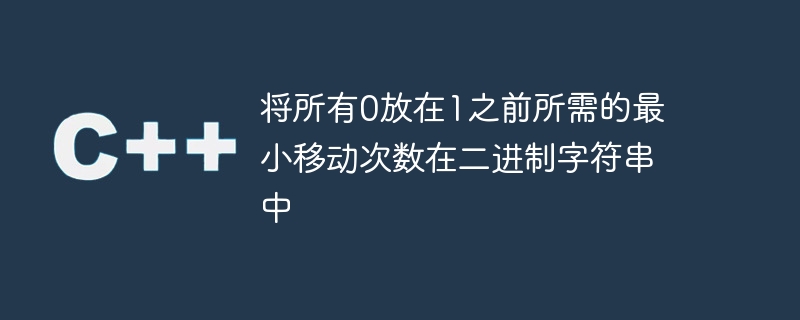将所有0放在1之前所需的最小移动次数在二进制字符串中

问题陈述
我们给定了二进制字符串 str,我们要求从字符串中删除最少的字符,以便我们可以将所有零放在 1 之前。
示例
输入
str = ‘00110100111’
输出
3
说明
这里,我们可以通过两种方式实现输出3。
我们可以从字符串中删除 arr[2]、arr[3] 和 arr[5] 或 arr[4]、arr[6] 和 arr[7]。
输入
str = ‘001101011’
输出
2
说明
我们可以删除 arr[4] 和 arr[6],将所有零放在 1 之前。
输入
str = ‘000111’
输出
0
说明
在给定的字符串中,所有零都已放置在 1 之前,因此我们不需要从给定字符串中删除任何字符。
方法 1
在第一种方法中,我们将使用两个数组。第一个数组将所有 1 存储在左侧,另一个数组将所有 0 存储在右侧。之后,我们可以将两个数组中第 i 个索引处的元素相加,并找到最小总和。
算法
第 1 步 - 定义长度为 n 的“零”和“一”命名列表,其中 n 是我们可以使用 size() 方法获取的字符串的长度。< /p>
步骤 2 - 如果给定字符串中的第一个字符是“1”,则将 1 存储在“ones”数组的第 0 个索引处;否则,存储 0。
步骤 3 - 使用 for 循环从字符串的第二个元素开始遍历。在 for 循环中,使用根据第 i 个索引处的字符串的字符将 Ones[i-1] 与 1 或 0 相加得到的结果值来初始化 Ones[i]。
第 4 步 - 根据给定字符串中的最后一个字符,将 1 或 0 存储在 Zeros[n-1] 处。
步骤 5 - 使用 for 循环从最后第二个字符开始遍历字符串,并根据字符串字符更新零列表的值。
< /里>第 6 步 - 定义“min_zeros_to_remove”变量并使用最大整数值对其进行初始化。
第 7 步 - 现在,遍历“零”和“一”列表。从零列表中的“i+1”索引和“一”列表中的“I”索引访问值。之后,添加这两个元素。
步骤 8 - 如果“min_zeros_to_remove”的值小于“min_zeros_to_remove”变量的当前值,则将其值更改为两个数组元素的总和。
< /里>步骤 9 - 返回结果值。
示例
#include <bits/stdc++.h>
using namespace std;
int minimumZeroRemoval(string str){
int n = str.size();
// arrays to store the prefix sums of zeros and ones
vector<int> zeros(n);
vector<int> ones(n);
// compute total number of 1s at the left of each index
ones[0] = (str[0] == '1') ? 1 : 0;
for (int i = 1; i < n; i++) {
ones[i] = ones[i - 1] + ((str[i] == '1') ? 1 : 0);
}
// compute total number of 0s at the right of each index
zeros[n - 1] = (str[n - 1] == '0') ? 1 : 0;
for (int i = n - 2; i >= 0; i--){
zeros[i] = zeros[i + 1] + ((str[i] == '0') ? 1 : 0);
}
// do the sum of zeros and ones for each index and return the minimum value
int min_zeros_to_remove = INT_MAX;
for (int i = 0; i < n - 1; i++){
min_zeros_to_remove = min(min_zeros_to_remove, zeros[i + 1] + ones[i]);
}
return min_zeros_to_remove;
}
int main() {
string str = "00110100111";
int count = minimumZeroRemoval(str);
cout << "The minimum number of zeros required to remove from the given string is - " << count;
return 0;
}
输出
The minimum number of zeros required to remove from the given string is - 3
时间复杂度 - O(N),因为我们需要 for 循环来遍历大小为 N 的字符串和列表。
空间复杂度 - O(N),因为我们使用两个列表来存储 1 和 0 的计数。
方法2
此方法是第一种方法的优化版本。在这里,我们使用两个变量来存储 1 和 0 的计数,而不是列表。
算法
第 1 步 - 定义“zeros_right”变量并使用 0 进行初始化。
第 2 步 - 遍历字符串,计算给定字符串中“0”字符的总数,并据此更新“zero_right”变量的值。< /p>
第 3 步 - 定义“ones_left”变量并初始化为 0。
步骤 4 - 使用 for 循环遍历字符串。如果字符串中第 i 个索引处的字符为“1”,则将“ones_left”变量的值增加 1。否则,将“zeros_right”变量的值减少 1。
第 5 步 - 如果“zeros_right + Ones_left”小于“res”变量的当前值,则更新“res”变量的值。
示例
#include <bits/stdc++.h>
using namespace std;
// function to remove zeros from the string to place all zeros before 1.
int minimumZeroRemoval(string str){
// counting the total number of zeros in the given string
int zeros_right = 0;
for (int i = 0; i < str.size(); i++) {
if (str[i] == '0')
zeros_right += 1;
}
// variable to store the number of ones from left
int ones_left = 0;
// Size of the string
int len = str.size();
// variable to store the final result
int result = INT_MAX;
// Traverse the string from left to right
for (int i = 0; i < len; i++){
// If the current character is '1', then increment ones_left by 1 else, decrement zeros_right by 1
if (str[i] == '1') {
ones_left += 1;
} else {
zeros_right -= 1;
}
// Store the minimum result and zeros_right + ones_left in result
result = min(result, zeros_right + ones_left);
}
// Return the final result
return result;
}
int main() {
string str = "001101011";
int count = minimumZeroRemoval(str);
cout << "The minimum number of zeros required to remove from the given string is - " << count;
return 0;
}
输出
The minimum number of zeros required to remove from the given string is - 2
时间复杂度 - O(N),当我们迭代字符串时。
空间复杂度 - O(1),因为我们仅使用常量空间。
结论
用户学习了两种从给定二进制字符串中删除最少字符的方法。第二种方法的代码更具可读性,因为我们使用变量来存储零和一的计数,而不是使用列表。
以上是将所有0放在1之前所需的最小移动次数在二进制字符串中的详细内容。更多信息请关注PHP中文网其他相关文章!

热AI工具

Undresser.AI Undress
人工智能驱动的应用程序,用于创建逼真的裸体照片

AI Clothes Remover
用于从照片中去除衣服的在线人工智能工具。

Undress AI Tool
免费脱衣服图片

Clothoff.io
AI脱衣机

Video Face Swap
使用我们完全免费的人工智能换脸工具轻松在任何视频中换脸!

热门文章

热工具

记事本++7.3.1
好用且免费的代码编辑器

SublimeText3汉化版
中文版,非常好用

禅工作室 13.0.1
功能强大的PHP集成开发环境

Dreamweaver CS6
视觉化网页开发工具

SublimeText3 Mac版
神级代码编辑软件(SublimeText3)
 最长非递增子序列在一个二进制字符串中
Sep 07, 2023 pm 11:13 PM
最长非递增子序列在一个二进制字符串中
Sep 07, 2023 pm 11:13 PM
在这个问题中,我们需要找到给定字符串的最长非递增子序列。非递增的意思是字符要么相同,要么按降序排列。由于二进制字符串仅包含“0”和“1”,因此生成的字符串应以“1”开头并以“0”结尾,或者以“0”或“1”开头和结尾。为了解决这个问题,我们将统计字符串每个位置的前缀“1”和后缀“0”,并找到前缀“1”和后缀“0”的最大和。问题陈述-我们给出了二进制字符串str。我们需要从给定的字符串中找到最长的非递增子序列。示例Input–str="010100"Output–4说明最长的非递
 在PHP中,pack()函数的作用是将数据转换为二进制字符串
Aug 31, 2023 pm 02:05 PM
在PHP中,pack()函数的作用是将数据转换为二进制字符串
Aug 31, 2023 pm 02:05 PM
pack()函数将数据打包到二进制字符串中。语法pack(format,args)参数格式-要使用的格式。以下是可能的值-a-NUL填充字符串A-空格填充字符串h-十六进制字符串,低半字节在前H-十六进制字符串,高半字节在前c-带符号字符C-无符号字符s-带符号短字符(始终为16位,机器字节顺序)S-无符号短整型(始终为16位,机器字节顺序)n-无符号短整型(始终为16位,大端字节顺序)v-无符号短整型(始终为16位,小端字节顺序)i-有符号整数(取决于机器的大小和字节顺序)I-无符号整数(取决
 使用C++编写,找到以1开头的二进制字符串的唯一排列数量
Sep 05, 2023 am 09:01 AM
使用C++编写,找到以1开头的二进制字符串的唯一排列数量
Sep 05, 2023 am 09:01 AM
在给定的问题中,我们得到一个由0和1组成的字符串;我们需要找到以1开头的所有排列的总数。由于答案可能是一个巨大的数字,所以我们将其取模1000000007后输出。Input:str="10101001001"Output:210Input:str="101110011"Output:56我们将通过应用一些组合数学和建立一些公式来解决这个问题。解决方案的方法在这个方法中,我们将计算0和1的数量。现在假设n是我们字符串中出现的1的数量,m是我们字符串中出现的0
 检查一个字符串是否可以通过交换二进制字符串中具有不相等字符的索引处的字符对来形成回文字符串
Sep 02, 2023 pm 08:09 PM
检查一个字符串是否可以通过交换二进制字符串中具有不相等字符的索引处的字符对来形成回文字符串
Sep 02, 2023 pm 08:09 PM
问题陈述我们有一个字符串str和一个二进制字符串B。两个字符串的长度都等于N。我们需要检查是否可以通过在字符串B中包含不相等字符的任意索引对上多次交换其字符,使字符串str成为回文字符串。示例示例输入str=‘AAS’B=‘101’输出‘YES’Explanation的中文翻译为:解释我们可以交换str[1]和str[2],因为B[1]和B[2]不相等。最终的字符串可以是'ASA'。输入str=‘AASS’B=‘1111’输出‘No’Explanation的中文翻译为:解释我们无法使字符串回文,
 找到在将一个二进制字符串清空(通过移除非空子字符串)后,0的数量最少的玩家
Sep 16, 2023 am 10:21 AM
找到在将一个二进制字符串清空(通过移除非空子字符串)后,0的数量最少的玩家
Sep 16, 2023 am 10:21 AM
在本文中,我们将讨论一个有趣的问题,涉及到字符串操作和博弈论领域:“通过删除非空子字符串来清空二进制字符串,找到剩余0最少的玩家”。这个问题探索了使用二进制字符串进行竞技游戏的概念。我们的目标是在游戏结束后找出剩余0最少的玩家。我们将讨论这个问题,提供一个C++代码实现,并通过一个例子来解释这个概念。理解问题陈述给两个玩家一个二进制字符串,他们轮流玩游戏。在每一回合中,玩家移除至少包含一个“1”的非空子串。当字符串变空或字符串中没有“1”时,游戏结束。无法采取行动的玩家输掉游戏。任务是找到最终0
 计算长度为N的二进制字符串,它们是子字符串的重复拼接
Sep 07, 2023 am 10:13 AM
计算长度为N的二进制字符串,它们是子字符串的重复拼接
Sep 07, 2023 am 10:13 AM
本文的目的是实现一个程序,用于计算由一个子字符串重复连接而成的长度为N的二进制字符串的数量。目标是确定通过重复连接给定文本的单个子字符串,可以创建多少长度为N的二进制字符串,其中N是一个正整数。问题陈述实现一个程序,用于计算重复连接子字符串的长度为N的二进制字符串的数量。示例示例1LetustaketheInput,N=3Output:2Explanation的中文翻译为:解释下面列出了长度为N=3的可行二进制字符串,其中重复连接了一个子字符串。"000":Thesubstr
 通过从给定的二进制字符串中选择相等长度的子字符串,最大化给定函数
Aug 28, 2023 am 09:49 AM
通过从给定的二进制字符串中选择相等长度的子字符串,最大化给定函数
Aug 28, 2023 am 09:49 AM
给定两个相同长度的二进制字符串str1和str2,我们必须通过从给定的相同长度的字符串中选择子字符串来最大化给定的函数值。给定的函数是这样的-fun(str1,str2)=(len(子字符串))/(2^xor(sub1,sub2))。这里,len(substring)是第一个子字符串的长度,而xor(sub1,sub2)是给定子字符串的异或,因为它们是二进制字符串,所以这是可能的。示例Input1:stringstr1=10110&stringstr2=11101Output:3说明我们
 将所有0放在1之前所需的最小移动次数在二进制字符串中
Sep 23, 2023 pm 01:29 PM
将所有0放在1之前所需的最小移动次数在二进制字符串中
Sep 23, 2023 pm 01:29 PM
问题陈述我们给定了二进制字符串str,我们要求从字符串中删除最少的字符,以便我们可以将所有零放在1之前。示例输入str=‘00110100111’输出3说明这里,我们可以通过两种方式实现输出3。我们可以从字符串中删除arr[2]、arr[3]和arr[5]或arr[4]、arr[6]和arr[7]。输入str=‘001101011’输出2说明我们可以删除arr[4]和arr[6],将所有零放在1之前。输入str=‘000111’输出0说明在给定的字符串中,所有零都已放置在1之前,因此我们不需要从






